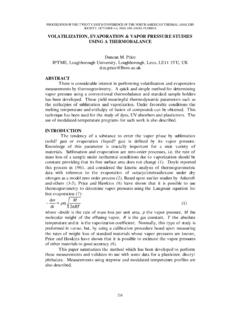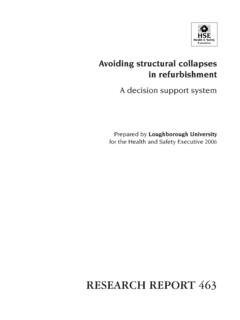Transcription of Thermal Conductivity of PTFE and PTFE Composites
1 PROCEEDINGS OF THE TWENTY-EIGTH CONFERENCE OF THE NORTH AMERICAN Thermal ANALYSISSOCIETY, OCTOBER 4-6, 2000, ORLANDO, FLORIDA579 Thermal Conductivity OF ptfe AND ptfe COMPOSITESD uncan M. PriceIPTME, Loughborough University, Loughborough, Leics. LE11 3TU, JarrattDepartment of Physics, University of Warwick, Coventry CV4 7AL, UKABSTRACTThe Thermal Conductivity of polytetrafluoroethylene ( ptfe ) was studiedusing an instrumented Thermal Conductivity apparatus (Lees Disk) and by former method was used to study the effect of incorporating fillers into aPTFE/glass fiber fabric used for conveyor belts in food processing. The effect ofcrystallinity on Thermal Conductivity was investigated and different methods ofcrystallinity determination were Polytetrafluoroethlylene ( ptfe ) exhibits useful properties over the widesttemperature range of any known polymer.
2 At one end of the temperature scale,the polymer possesses unusual toughness at cryogenic temperatures. ptfe alsohas an usually high virgin crystalline melting point (342 C), extremely high shearviscosity (1011 Poise at 380 C) in the melt and outstanding Thermal stability. Thepolymer is insoluble in all common solvents and is highly resistant to chemicalattack. Its combination of electrical properties is outstanding with high dielectricstrength and extremely low dielectric loss. The polymer is uniquely non-adhesiveand anti-frictional. These factors mean that although ptfe is expensive anddifficult to process, it has many uses ranging from bearings and gaskets tobreathable fabric and frying particular interest in this study are ptfe impregnated glass fiberfabrics which are prepared by dip coating glass fiber fabric with an aqueousdispersion of polymer, drying and then sintering the ptfe to achieve goodadhesion and homogeneity.
3 The end product is used in applications such astunnel oven conveyor belts (in particular for the food industry) and architecturalcoverings where the unique properties of ptfe are required. This paper discussesaspects of a wider ranging project to provide fundamental information about thesematerials relevant to the manufacturing and end use (1). To this end, techniqueswere developed to measure the Thermal Conductivity and crystallinity of PFTEand ptfe /glass Composites so as to study their of ptfe and polymethylmethacrylate 3 mm thick sheet weresupplied by ICI (UK). ptfe /glass fiber mats (some with added aluminum580powder) were obtained from Fothergill Tygaflor (UK). Thermogravimetryshowed that the ptfe /glass fiber mats contained 60% by weight s Disk Thermal Conductivity ApparatusThe apparatus used was a modification of the standard Lees disk methodfor the measurement of Thermal Conductivity by the absolute plane parallel platetechnique.
4 Explanations of this technique can be found in various physicstextbooks (2). This method, in its classical form, utilizes a steam chest to providea temperature of 100 C on one side of the sample and subsequently coolingmeasurements in order to calculate the heat flow through the sample. However,the equipment used for this work employed electrical heating without the need forcooling measurements. A diagram of the apparatus is shown in figure 1 and iswidely used in school physics classes. This consists of three copper plates (A-C)drilled to accept liquid-in-glass thermometers and a 6W electrical plate heater ofthe same diameter as the copper plates (Griffin & George Ltd., Wembley,Middlesex, UK).The sample to be studied was cut to the same diameter as the copper plates(41 mm) and to a thickness of approximately 3 mm.
5 Several sheets of ptfe /glassfiber mats were used to build up the required thickness and liberally coated withpetroleum jelly to facilitate good Thermal contact. The specimen was then placedbetween copper plates A and B. The heater was sandwiched between plates Band C and, after tightening the clamp screw to hold all the discs together, thepower to the heater was switched on. The whole assembly was placed in anenclosure to minimize the effects of draughts and a fourth thermometer wasplaced within the enclosure, fairly close to the apparatus, to measure the ambienttemperature. At the beginning of each determination, the power from a stabilizedDC supply was turned on full until the average temperature of the sample ( themean of the temperature of plates A and B) reached the desired value.
6 The powerwas then adjusted to allow the temperatures of the plates to stabilize. This tookseveral hours, throughout which time readings were taken at 30 minute intervalsand, as equilibrium was reached, readings were taken every 10-15 minutes. Atthese times, in addition to the four temperature readings, the current and voltageapplied to the heater was monitored. When the temperature of all parts of theapparatus had been stable to within C for 30 minutes, a value for the thermalconductivity of the specimen ( ) of thickness d and radius r was calculated fromthe following:(1)where e is given by:(2)() ++ =AABASABTaTTaTTred2222 ++++++=CCBBcBHBASAATaTaTTaTTaTaVIe22581a A, aB, aC, aS and aH are the exposed surface areas of A, B, C and the specimenand heater respectively.
7 Areas aA and aC include the flat ends of the discs. TA, TBand Tc are the temperatures of the discs A, B and C above ambient (ie. the truetemperature of the disc minus the ambient temperature). V is the potentialdifference across the heater and I is the current which flows through it. The fullderivation of Eq. (1) and (2) gave be found in the manual which accompanies theapparatus (3).From the above it can be seen that working out for each sample by handwould be very laborious. These calculations were therefore performed using acomputer program which could accept data manually or take input directly from asix channel data logger (DataHog SDL2850, Skye Instruments, LlandrindodWells, Powys, UK). This measured the four temperatures using K-typethermocouples and the power supplied to the heater via two channels (0-10 V forheater voltage) and (0-1 V for the heater current via the voltage drop across a 1 Oresistor).
8 Following introduction of the data logger, the time taken to obtain areliable value for the Thermal Conductivity of specimen was reduced from six totwo Scanning CalorimetryDSC measurements were made using a TA Instruments 910 DSC undernitrogen. The instrument was calibrated for temperature and heat flow responseaccording to the melting points and heats of fusion of pure gallium, indium, tinand bismuth. Synthetic sapphire was used as a reference material for heatcapacity papers describe the use of differential scanning calorimeters tomeasure Thermal Conductivity (4-9). An advantage of using DSC is that thespecific heat capacity of the sample can be measured with the same instrumentand hence, if its density is known, the Thermal diffusivity of the sample ( /?)
9 Cp)can be found. For this work we used the method of Hakvoort and van Reijenwhereby both the temperature and heat flow into the base of the sample aremeasured (7). The temperature of the top surface of the sample cannot bemeasured directly; by applying a pure metal, placed on top of the sample, thetemperature of that side of the sample is defined during melting of the metal. Thislimits the temperatures at which determinations can be made to that of readilyavailable melting point standards. The Thermal Conductivity of the specimen ( ),thickness h and cross-sectional area A is given by:onsetffSmeasHlitHAh =.)(.)( (3)Where Hf(lit.) is the literature value for the heat of fusion of the metal, Hf(meas.) the measured value for the heat of fusion of the metal and Sonset is theslope of dH/dt vs.
10 T for the onset of melting of the AND DISCUSSIONThe accuracy of the Lees disk method for determining thermalconductivity was checked by sending test samples to the National Physical582 Laboratory, Teddington, Middlesex UK for measurement using a 76 mm diameterguarded hot plate apparatus whose calibration was traceable to national tests were carried out according to national and European standards (10) andthe specimens were returned for testing on the apparatus described above. At50 C, we obtained for PMMA and ptfe (199 & 259 mW m-1 C-1 respectively)to in good agreement with the certified values (194 & 264 mW m-1 C-1)from NPL who claim a similar level of of unsintered and sintered ptfe /glass mats supplied by themanufacturer were tested using the Lees' disk method.








